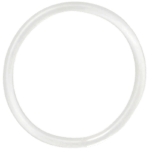How effective is the birth control ring?
As a method of birth control, the vaginal ring is one of the most effective available. When it’s used properly, it’s more than 99% effective. But when it’s used typically (making the occasional mistake, such as inserting it late), the effectiveness drops slightly to around 91% — which is still higher than typical use for condoms.
When to start using the vaginal ring
When to insert the vaginal ring depends on whether you’re already using hormonal birth control or not.
If you aren’t currently on hormonal birth control, you’ll insert the ring on the first day of your period. You’ll be protected straight away. If you wait to insert the ring between days two and five of your period, though, you should use condoms for the following week as your protection won’t start immediately. Whenever you’re using additional protection, don’t use a second hormonal method. Just use condoms.
If you’ve been taking the combined pill, insert the ring the day after taking any pill in the pack.
If you’re switching from the patch, insert the ring on the day you remove the patch. You should avoid any gaps in your protection.
If you’ve been getting the depo shot, you can insert the ring up to 15 weeks after your last injection.
You should let our clinician know if you’re switching from another birth control method during your consultation.
How to insert the vaginal birth control ring
Before you use the ring for the first time, it’s helpful to see your doctor or gynecologist in person so they can show you how to insert it properly. You’ll easily be able to do it yourself after that (or if you’ve had the ring before and already know the ropes), but it’s good to get a little help the first time to make sure you’re doing it correctly.
Always double-check the expiration date on your ring before you use it. Then, wash your hands and get into a comfortable position. You can try lying down, squatting or standing with one leg lifted up and balanced on a chair. Take the ring out of its packaging, hold it between your thumb and forefinger, squeeze it and push it up into your vagina using your index finger.
When you’ve got it in place, you shouldn’t feel it. If you can, or if it feels uncomfortable, you might need to push it in a little more.
After the ring has been in for three weeks, it’s time to take it out. You should change the ring on the same day of the week that you inserted it.
To take the ring out, insert your index finger into your vagina and hook it around the ring. Once you’ve hooked your finger around the rim, you should be able to pull the ring out. Taking the ring out should be a straightforward, easy process. If you have any problems getting the ring out, you should see your doctor or gynecologist right away.
Throw the ring away, but don’t flush it down the toilet. Some brands like the NuvaRing come with a foil pouch you can use for disposal.
This page was medically reviewed by
Ms Laurenmarie Cormier, Clinical Content Reviewer on August 02, 2022. Next review due on August 01, 2024.





